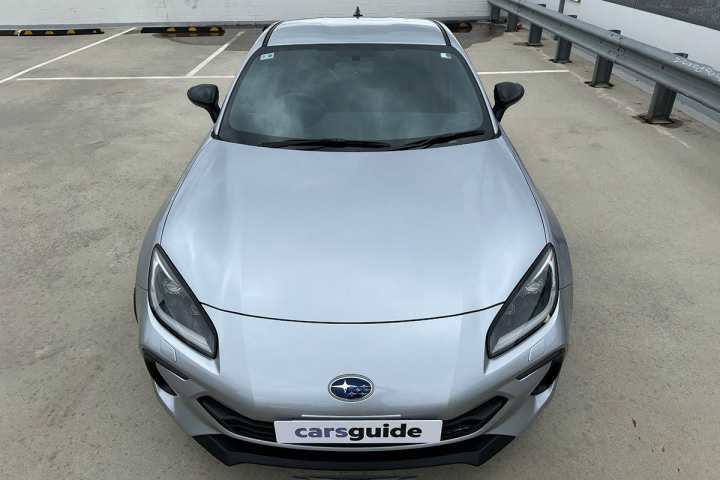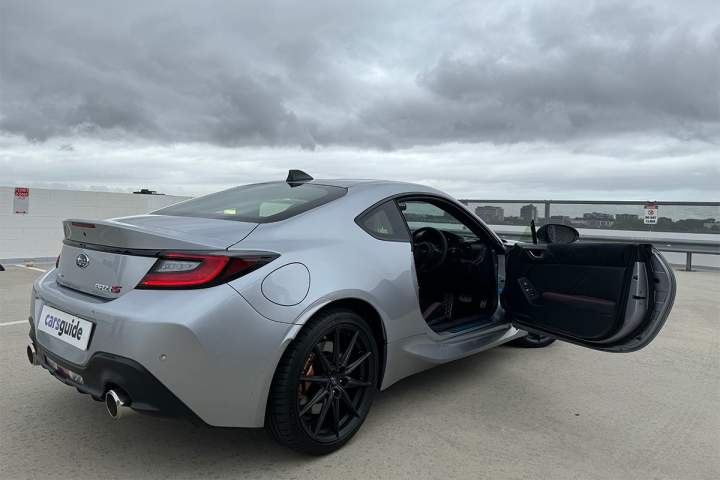In the 1990s, Australian sporty coupe buyers were spoiled for choice, with well over a dozen inexpensive sporty coupes wearing badges – now long since banished to oblivion – like CRX, 30X and 200SX.
Today, there are just three-ish… the Mazda MX-5, as well as the Subaru BRZ and its Toyota GR86 twin. All are brilliant and we’re grateful they’re around.
But if you think we’re being generous counting the Subaru and Toyota as separate entities, both are claimed to be unique in character and conduct.
This is especially so with the BRZ tS, the latest (and new flagship) addition to the second-generation model released back in 2022, ushering in dynamic and specification upgrades courtesy of in-house motorsport division Subaru Tecnica International, or STI.
FYI, tS stands for ‘tuned by STI’. And BRZ for 'Boxer engine Rear-wheel drive Zenith'. Appetite whetted yet? Ours is, so let’s dive right in and find out what this BRZ tS is all about.
Subaru BRZ 2024: TS
| Engine Type | Inline 4, 2.4L |
|---|---|
| Fuel Type | |
| Fuel Efficiency | 8.8L/100km (combined) |
| Seating | 4 |
| Price From | $49,690 |
| Safety Rating |
|
Does it represent good value for the price? What features does it come with?
9 / 10
With cheap coupes almost extinct nowadays, even at $48,690 (all prices are before-on-road costs), the costliest BRZ still represents exceptional value-for-money.
Here’s a plot twist, though. Our test tS is an auto, but only costs $1000 more, from $49,690. And it is pretty well equipped to boot.
Every BRZ includes four-wheel ventilated disc brakes, a mechanical limited-slip differential, keyless entry/start, adaptive LED headlights, dual-zone automatic climate control, an 8.0-inch touchscreen, a reversing camera, satellite navigation, digital radio, wired Apple CarPlay/Android Auto, heated and power-folding exterior mirrors and 18-inch alloy wheels.

And whether talking about the six-speed manual or auto, adaptive cruise control, lane-keep systems, tyre pressure monitors and other driver-assist safety technologies are now fitted across the range.
Based on the mid-range BRZ S specification, which over the base grade replaces cloth for a perforated suede-like material with leather trim and adds heated front seats, the tS brings STI-tuned suspension, Brembo brakes, darker alloys, blacked-out mirrors and roof antenna, a red/black interior trim combo, a push-button start and an STI-specific instrument cluster. All for a $3600 premium.
However, the laudable full-sized spare wheel in the other grades is turfed for a fiddly puncture repair kit. This is a retrograde step.

Plus, the factory will not supply a sunroof, smartphone charger or wireless connectivity for your Apple CarPlay/Android Auto, though of course your usual Bluetooth phone connectivity with associated streaming is present.
So, with all these items, the BRZ tS’ sub-$50K retail price is red-hot value against the gorgeous MX-5 RF, since you’ll need to step up to the mid-range GT costing about $5K more than the Subaru for keyless entry and heated seats.
But, while only two people can fit inside, the Mazda has that magnificent acrobatic electric targa roof that no Subaru can match.

Then it’s a substantial jump to $75,800 for the rousing Nissan Z, though that boasts almost double the engine outputs thanks to a ferocious twin-turbo V6 powerplant.
Whichever way you look at it, and whatever coupe you choose, we salute you, Japan Inc.
Is there anything interesting about its design?
9 / 10
Compared to the previous model, the latest BRZ has similar proportions but has changed in a few important ways.

For instance, the body is about 50 per cent stiffer than before. The bonnet, front mudguards and roof are now aluminium, and the fuel flap is plastic. This helps bring a 4.0mm drop in the centre of gravity, which benefits handling and ride dynamics.

The BRZ is longer then the first-generation version by 25mm (at 4265mm), has a wheelbase that’s been stretched by 5.0mm (to 2575mm), is 15mm shorter (at 1310mm) and has wider rear tracks (at 1550mm), but overall width (at 1775mm) remains the same.
Being a tS, STI has fitted special badges around the car, different alloys and uprated (Brembo) brakes, amongst other things. And the changes are just as subtle inside.
How practical is its space and tech inside?
8 / 10
Is there anything more retro than sitting down low in a sports car with just centimetres separating your buttocks from bitumen?
This is the BRZ experience, but once sat snug, ensconced in superbly supportive sports seats, you forget all about the fumbled entry and graceless egress that awaits and instead revel in the moment.
Arms outstretched, hands gripping a perfectly-sized wheel, ahead of crisp electronic instrumentation, with controls so intuitively placed and presented that soon everything’s operated via muscle memory, Subaru has nailed the ergonomics.
Oh, and the joy of a handbrake lever! It's just so naturally and beautifully driver-orientated.
Okay. Owners of the original (ZD6) generation will already know all this. So what’s changed? Besides nothing conceptually, basically everything executionally.
The dated old dash has been ditched for a dated – but much prettier – new fascia, that’s all horizontal layers and matt black plastic, just like Japanese sporty coupes were in the 1970s and ‘80s. Except for the 8.0-inch touchscreen, of course, which looks a little aftermarket with its low-res TomTom nav, but is easy to figure out and a cinch to use on the go.
The climate control and toggle switches are lovely to use, there’s bottle storage in each door and, as a bonus for going automatic, an extra beverage holder to the pair beneath the centre-console lids exists. This matters if you're regularly transporting thirsty passengers cramped out back. More on that in a moment.
Other than the contortions required to get in and out, the BRZ’s is actually shockingly practical – from the surprisingly good all-round vision afforded by all that glass area as well as thinner pillars and sleeker exterior mirrors than before, ample ventilation and handy storage, to front-seat comfort and a compliant ride.
Plus, you’ll soon learn that the frameless doors provide easier entry and exiting when their windows are down. You wouldn’t think twice about commuting in this baby. Cancel that expensive small SUV order now!
The tS’s extra suede-esque upholstery, baboon’s butt red starter button and STi instrumentation cluster lift the ambience above the cheap sports car vibe of the 2012 original, while the whole ensemble is superbly screwed, clipped and/or glued together.
Gripes? For such a recent model, the lack of a USB-C port anywhere in the BRZ is an oversight. There are no overhead grab handles to help haul yourself out. At speed there's too much road noise. And only the front passenger seat has a single-action slide-and-tilt motion with return for getting through to/from the back, meaning you’re forever grappling with seat levers if you need to enter/exit from the driver’s side.
Now, granted, the rear pair of seats are occasional-only for taller folk, but there’s every chance the '+2' element of the Subaru is the main reason you’d be pondering one of these over, say, the strictly two-seater MX-5.
At 178cm, your tester just about hits the height limit for back-seat accommodation. Actually, the cushion and backrest base are thoughtfully padded and angled, but scalps scrape ceiling and/or glass depending on posture, the front-seat occupants need to slide their chairs forward for knees to fit and there’s barely any space for bigger feet.
But then, this is not the point of a coupe. The fact the BRZ is fine for shorter trips adds another level of practicality, even if there are no grab handles or reading lights to access. And, thoughtfully, the cabin engineers created the centre console lid to remain open for rear-seat access to cupholders, two USB-A ports and a single aux (!) outlet.
That's why the auto's extra cupholder comes in so handy.
Further back, the one-piece backrest folds flat to boost cargo-carrying practicality and versatility, since the boot is a modest 201 litres in capacity. And, it’s now easier to do that thanks to a boot-sited backrest release. It beats having to clamber inside the car every time, as per the earlier generation BRZ.
Keep in mind the tS loses the other BRZ grades’ full-sized spare wheel, presumably in the name of dynamic precision. A tyre-inflation kit is a poor substitution in puncture-prone Australia.
Oh well. At least you’ll be in a pleasant and charming coupe environment whilst you wait for roadside assistance.
What are the key stats for its engine and transmission?
9 / 10
Under the BRZ’s bonnet is the same 2.4-litre horizontally-opposed ‘boxer’ four-cylinder petrol engine, with double overhead cams and direct-injection.

Power is rated at 174kW at a heady 7000rpm while the 250Nm torque maximum kicks in at 3700rpm. Tipping the scales at about 1310kg, the power-to-weight ratio is an impressive 133kW/tonne.
The boxer engine drives the rear wheels only via a six-speed manual or, in this case, an Aisin-supplied six-speed torque-converter automatic transmission with paddle shifts.
What is its fuel consumption? What is its driving range?
7 / 10
The BRZ is not tuned to save money at the petrol bowser.
What did we manage? Air-con on always and driven hard often with fuel-sapping performance testing included, our not-fully-run-in tS returned a commendable 10.2L/100km, while the car’s trip computer read out was 9.7L/100km.

Subaru says owners of the automatic model should expect to average 8.8L/100km on the combined cycle. Choosing to go manual bumps that up to 9.5L/100km.
As a result, the carbon-dioxide emissions rating is 201g/km (auto) and 217g/km (manual).
Note that filling the BRZ auto’s 50-litre fuel tank with the required 98 RON premium unleaded petrol should eek out nearly 570km between refills using the combined cycle figure.
What's it like to drive?
10 / 10
The brilliant thing about the BRZ/GR86 twins is they’re just so great to drive regardless of transmission.
And, after a week behind the wheel of the BRZ tS auto, there are even unique benefits to make a very strong case in its favour over the admittedly incredibly satisfying manual.
The numbers tell a compelling story.
With an impressive 133kW/tonne (or thereabouts) thanks to a larger engine (with 18 per cent more power and 20 per cent more torque than before) and a tight-ratio six-speed auto, the BRZ springs off the line with an almost frenetic liveliness, providing snarly, punchy performance right to its lofty 7500rpm red line.
Select manual mode and the auto will also hold bounce off the rev limiter.
Okay. It’s still not sports car fast, per se, with relatively modest outputs and a 0-100km/h time in the mid-six second bracket, but what there is works hard to make you feel like you’re going very quickly. That said, the BRZ will bowl along at quite a cracking pace.
Select 'Sport' mode, and there’s even more urgency, with the sweetly-calibrated auto hanging on to its ratios a little longer. Here’s where the Tiptronic-style lever/paddle shifters come into play, allowing for that extra level of interactivity.

Even with out test car's odo well under 1000km, this boxer engine has a very deep set of lungs and a lot of bandwidth to explore.
The generational change that saw the swapping out of the old 2.0-litre for this torquier 2.4L seems to be for the benefit of the auto.
And that’s not even the best bit.
The BRZ skates along with an Olympian’s confidence and control, providing an agility and grace reserved for Porsches, Lotuses and the like.
And it’s not just the wonderfully tactile steering at work either, because this possesses that rare seat-of-the-pants connection that makes the driver feel like part to the car.
Suspension is by MacPherson struts up front and a double-wishbone arrangement. Subaru reckons weight distribution is a close-to-ideal 53:47 front/rear.
Like all second-gen BRZ/GR86 models, the architecture underneath is loosely based on Subaru’s small-car platform that dates back decades, though it has been significantly updated and improved along the way.
If you love the sort of driving where you long to sense the road, corner with the throttle and swing out the rear of the car using just your hips, then the tS is your sort of sports car.
From the brilliant brakes to the nuanced tune of the traction control systems, balanced precision is the name of the game here. It tingles senses like an ASMR sensation. The fact this is as an auto does not change anything.

And, you know what? The uprated STI dampers even seem to benefit ride quality, because while the tS is obviously a taut and muscular drift-ready machine, the suspension is never too stiff or hard, allowing this BRZ to be more than capable as a commuting machine.
Yep, even over craggy inner-urban pot-holed and tram-lined roads, the Subaru’s comparative comfort and sophistication only endeared us to it even more.
So, surely there are downsizes, right? Well, the Michelin Pilot 4 215/40R18 tyres sure love to amplify road noise inside. This is not a quiet car over some of our coarser bitumen surfaces, and it can quickly become tiresome.
And… that’s it for criticism from a driving point of view. The BRZ tS can put a smile on your face just like MX-5s and Caymans can. Even/especially the auto if you will seek to schlepp around in one every single day with a minimum of fuss.
And all for around $52K drive-away. Bargain. Where do we sign up?
Warranty & Safety Rating
What safety equipment is fitted? What safety rating?
8 / 10
Unlike the previous BRZ, the second-gen version does not have an ANCAP rating.
Subaru says it has taken the old platform and applied elements of its newer architecture to improve front lateral flexing rigidity by almost 60 per cent and body torsional rigidity by approximately 50 per cent.
The body sees beefier body-welding techniques, reinforced (yet slimmer for improved driver vision out) A- and B-pillars, and an increase in hot-pressed materials, high-tensile steels and aluminium in impact areas make for better occupant safety.
Seven airbags are fitted (dual front, front side, curtain and driver’s knee), along with Subaru’s 'EyeSight' preventative safety system featuring AEB with 'Pre-Collision Brake Assist', blind-spot monitoring, rear cross-traffic alert, 'Reverse Automatic Braking', lane change assist, 'Lane Departure Warning' (LDW), 'Lane Sway Warning', 'Lead Vehicle Start Alert', 'High Beam Assist' and adaptive cruise control (with full-stop functionality).

All manual as well as automatic BRZs now have the full driver-assist tech suite included as standard.
Also present are tyre pressure monitors, Brembo ventilated four-wheel disc brakes, a mechanical limited-slip differential, electronic stability control, anti-lock brakes with 'Electronic Brakeforce Distribution' and 'Brake Assist', traction control, 'Brake Limited Slip Device', a 'Brake Override System' and a reversing camera.
There is no data on the AEB speed/operation parameters at the time of publishing, but the LDW activates from 50km/h.
Finally, three child-seat tether points and two ISOFIX anchor points are fitted in the rear.
What warranty is offered? What are its service intervals? What are its running costs?
8 / 10
All Subaru BRZs come with a five-year/unlimited kilometre warranty, as well as one year’s free roadside assistance. Service intervals are at 12 months or 15,000km, whichever comes first.
There is five years/75,000km of capped-price servicing available, with the first starting from around $365, then stretching to $586, $460, $825 and $380 for an average of $523.
Verdict
Just in case you haven’t figured it out, we’re deeply in love with the BRZ tS. It’s a sublime beauty with a tantalising breadth of talent, while still being affordable and practical enough as an everyday run-around.
And, yep, even with the auto, the BRZ tS is its own and very special thing. Do it before coupes die out completely.
Pricing Guides

Range and Specs
| Vehicle | Specs | Price* |
|---|---|---|
| 10TH Anniversary Edition | 2.4L, 6 SPEED AUTOMATIC | $46,890 |
| Base | 2.4L, 6 SPEED AUTOMATIC | $44,090 |
| Base | 2.4L, 6 SPEED MANUAL | $40,290 |

























.jpg)

_0.jpg)





.jpg)



.jpg)

.jpg)


.jpg)

Comments